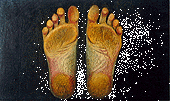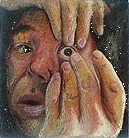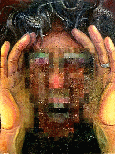by Paul Hutchinson
Click on image for a larger view
 |
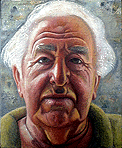 |
| My Parents | |
|
|
||
| My Own Two Feet | Contact |
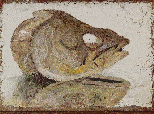 |
|
|
| Fish Skull | FAQ |
| Encaustic Wax Encaustic (literally means "burning in") Wax Painting is a method of painting using hot molten wax as the medium. It was one of the earliest mediums used for easel painting. It was used in Greece 1500 years ago - often for burial portraits. The fact that many of these paintings have survived in brilliant conditions to the present day attests to its permanence. The medium consists quite simply of dry pigment mixed into melted beeswax, sometimes with a little damar resin added. The "paint" is applied whilst hot to the painting support - which can be virtually anything such as canvas, paper, hardboard, wood or even glass or metal. The support can be kept warm while working to keep the wax fluid. If painted on a cool surface the wax will set almost instantaneously, allowing layers of colour to be built up very quickly. I work by using a small oven to heat the wax. I use conventional brushes to apply the wax sometimes, but more often I work with heated spatulas or palette knives to manipulate the wax directly on the painting. I also like to pour and drip the wax colours directly onto the support and let it drip down like . . . ummm . . . . molten wax! I like using the wax with only a little pigment in it to get a semi-transparent effect. It's also good combined with collage or with actual objects embedded in the wax. I have also developed a technique where I use wax crayons (which I make myself using the same wax and pigment medium poured into moulds). I like to rub the crayons over heavily textured areas of the painting in a sort of "scumbling" effect to bring out the texture. The techniques and possibilities of this often over-looked medium are virtually limitless. |
